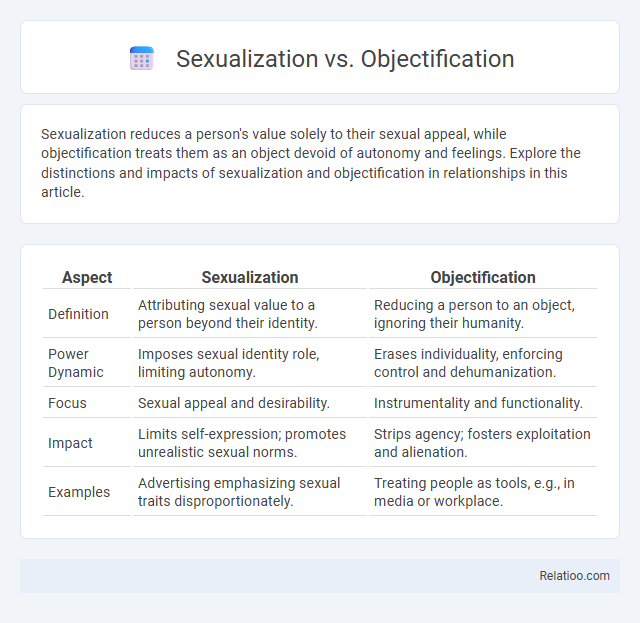Sexualization reduces a person's value solely to their sexual appeal, while objectification treats them as an object devoid of autonomy and feelings. Explore the distinctions and impacts of sexualization and objectification in relationships in this article.
Table of Comparison
| Aspect | Sexualization | Objectification |
|---|---|---|
| Definition | Attributing sexual value to a person beyond their identity. | Reducing a person to an object, ignoring their humanity. |
| Power Dynamic | Imposes sexual identity role, limiting autonomy. | Erases individuality, enforcing control and dehumanization. |
| Focus | Sexual appeal and desirability. | Instrumentality and functionality. |
| Impact | Limits self-expression; promotes unrealistic sexual norms. | Strips agency; fosters exploitation and alienation. |
| Examples | Advertising emphasizing sexual traits disproportionately. | Treating people as tools, e.g., in media or workplace. |
Understanding Sexualization and Objectification
Sexualization occurs when a person's value is primarily defined by their sexual appeal or behavior, often disregarding their other attributes or identity. Objectification involves treating an individual as a mere object or tool for use, stripping away their autonomy and subjectivity. Understanding the distinction highlights that sexualization emphasizes sexual traits, while objectification reduces a person to an object regardless of sexual context.
Key Differences Between Sexualization and Objectification
Sexualization involves attributing sexual qualities or roles to a person, often emphasizing their sexual appeal or behavior, whereas objectification reduces a person to an object, focusing solely on their physical attributes without regard to their personality or humanity. The key difference lies in sexualization emphasizing sexual identity or roles, while objectification dehumanizes by treating individuals as mere instruments for others' pleasure. Understanding these distinctions is crucial for addressing issues related to media representation, gender studies, and psychological impacts on self-perception.
Historical Context of Sexualization
Sexualization historically emerged as a cultural mechanism to control and define female bodies in relation to male pleasure, rooted in patriarchal societies where women's roles were primarily reproductive and ornamental. Your understanding deepens by recognizing how early art, literature, and legal systems codified sexualization to reinforce gender hierarchies and justify exclusion from public and political life. This historical context reveals that sexualization is not merely about attraction but a complex social process shaping identity and power dynamics over centuries.
The Evolution of Objectification in Media
Media's portrayal of objectification has evolved from overtly reducing individuals to mere bodies or objects toward more nuanced depictions that still emphasize physical attributes over identity. Sexualization often overlaps with objectification but specifically highlights the portrayal of individuals as sexual objects, while objectification broadly diminishes their personhood regardless of context. Your understanding of these distinctions is crucial as media continues to shape societal perceptions and reinforce gender stereotypes through evolving visual and narrative strategies.
Impacts on Self-Perception and Identity
Sexualization, objectification, and commodification each uniquely impact self-perception and identity by framing individuals primarily as bodies or objects for external evaluation, often diminishing personal agency. Sexualization leads to prioritizing physical appearance over intrinsic qualities, while objectification strips away individuality, reducing people to tools for others' pleasure; commodification treats identities as marketable products, eroding authenticity. Recognizing these distinctions helps you understand how external portrayals influence internal self-concept and fosters awareness for healthier identity development.
Gender Perspectives: Who Is Most Affected?
Sexualization disproportionately affects women and girls by reducing their worth to sexual appeal, often perpetuating harmful gender stereotypes. Objectification, particularly prevalent in media and advertising, frequently targets females by treating them as mere objects for male pleasure, reinforcing gender power imbalances. While men experience objectification, the intensity and societal impact are significantly greater on women due to entrenched patriarchal norms and cultural expectations.
Sexualization vs. Empowerment: A Fine Line
Sexualization often reduces individuals to their sexual appeal, stripping away their full identity, whereas empowerment embraces sexual expression as a form of agency and self-confidence. The fine line between sexualization and empowerment depends on context, intent, and the presence of consent, allowing individuals to reclaim their sexuality rather than being defined by external perceptions. Navigating this boundary requires a critical understanding of power dynamics, representation, and respect for autonomy to ensure sexuality is a tool of empowerment rather than exploitation.
The Role of Pop Culture and Advertising
Pop culture and advertising significantly shape perceptions of sexualization and objectification by promoting images that emphasize physical appearance over individuality. Sexualization often occurs when individuals are portrayed primarily as objects of sexual desire, while objectification reduces them to mere instruments for visual pleasure, stripping away agency and personality. These representations in media reinforce harmful stereotypes, influencing societal attitudes and behaviors toward gender and identity.
Psychological and Societal Consequences
Sexualization occurs when individuals are valued primarily for their sexual appeal, leading to diminished self-esteem and increased anxiety, while objectification involves perceiving people as mere objects, fostering dehumanization and emotional detachment. Both processes contribute to perpetuating gender inequality, reinforcing harmful stereotypes that limit personal identity and social roles. Psychological consequences include depression and body dissatisfaction, whereas societal impacts manifest in normalized harassment and skewed power dynamics.
Strategies for Healthy Representation
Promoting healthy representation involves distinguishing sexualization, which highlights explicit sexual appeal, from objectification, where a person is reduced solely to their body or attributes without agency. Strategies include emphasizing characters' full humanity, showcasing diverse personalities and strengths, and fostering narratives that respect autonomy and consent. By prioritizing these approaches, your media can challenge harmful stereotypes and encourage more respectful, multidimensional portrayals.

Infographic: Sexualization vs Objectification
 relatioo.com
relatioo.com